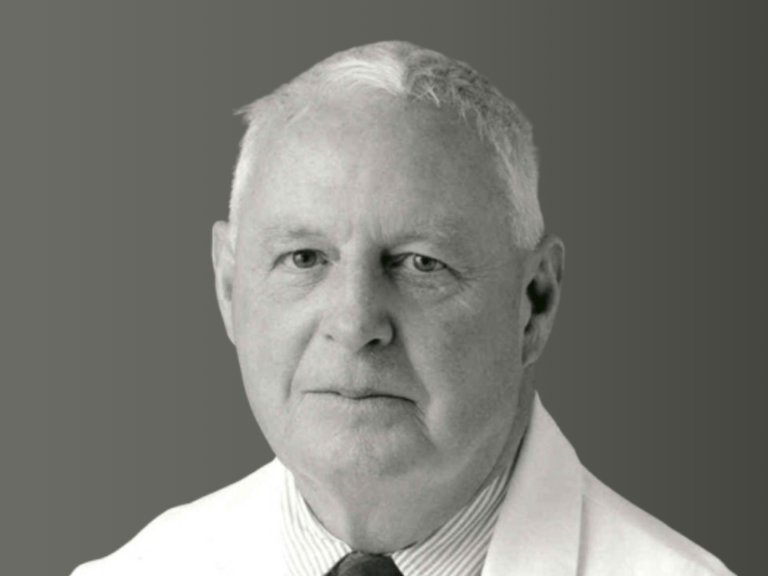Pointing out that NCI’s budget has decreased in real dollars since 1976, John Ultmann, president of the Assn. of American Cancer Institutes, called on Congress for more adequate funding of the National Cancer Program and for renewal of the National Cancer Act.
Ultmann, director of the Univ. of Chicago Cancer Center, made his appeal at a seminar AACI held for members of Congress and their staffs during the annual meeting in Washington of the organization.
Ultmann’s presentation:
“At a time in history when science is poised to answer some of the most fundamental questions in biology, and to make some of the most far reaching discoveries to solve problems bearing on disease and its prevention and cure, the scientific community is confronted by the prospects of cutbacks of support which will have an immediate crippling effect on current research and a long term detrimental effect on the recruitment of the next generation of scientists, on the quality of the plants in which research is done, and on the tools with which discoveries are made.
“Now some of the facts to back the message: Let’s first talk about accomplishments of the National Cancer Program in a broad scope.
“I will not go into details of basic research or clinical research in prevention, detection, and therapy and the interdigitation all these into a cohesive national and international program. Let me simply say that the National Cancer Institute has developed the most effective national program of cancer research and control in the history of mankind and that these efforts have already resulted in a reduction in cancer mortality.
“These efforts involve every medical school, cancer center, and most teaching hospitals, all participating in the search for the cause, prevention and cure of cancer. Major commitments have been made by the universities and the cancer centers in space, personnel and funds to make the National Cancer Program work. And work it does.
“We have witnessed during this time major progress in biology, a revolution in molecular biology, including the genetics of cancer, ongogenes, anti-oncogenes, and viral transforming genes all leading to new opportunities in diagnosis and treatment. And the revolution in molecular immunology has led to monoclonal antibodies produced by hybridoma technology, which open up new vistas in research itself and serve as diagnostic and therapeutic tools.
“In the clinical area, new diagnostic tests and new strategies for staging and treatment have been developed and tested. the therapeutic results in a number of tumors have been markedly improved by new drugs, multidrug combinations, combined modality approaches, adjuvant therapy and biologic response modifiers.
“These research accomplishments have been translated by centers and community oncology programs into procedures which assure comprehensive treatment for almost all Americans. This, in turn, has led to a reduction of mortality, and a reduction in cost by cure and an increase in productivity and in the number of former cancer victims.
“The reductions in mortality have been noted in a variety of cancers which were, in the mid 1970s, largely fatal: testicular cancer reduction 43%; ovarian cancer, 40%; breast cancer, 15%; and now even diffuse non-Hodgkin’s lymphoma, 30%.
“These reductions in mortality… are cost effective. The medical cost savings in any one year from these reductions by new therapeutic modalities, especially chemotherapy and adjuvant therapy, are estimated to be $1 billion because initial treatment, which cures, is much less expensive than the cost of treating the patient who is not cured. Further reductions in mortality planned for the Year 2000 by NCI will lead to further cost savings.
“Every single year, if we do nothing else, $1.135 billion will be saved just because it is cheaper to cure than to palliate. That is the first saving.
“The second is that each cohort of patients which is cured will contribute, each year, for the rest of their lives, $6.209 billion. So we have already $7 billion a year that we are ahead with cancer research results of the past, which are possible to implement today.
“If we translate this further to the Year 2000 and save an additional 288,000 individuals, you can see that we will be plowing back into the national treasury so much money that the current research expenditures will be repaid many times over.
“In addition to these accomplishments, there is a tremendous interdigitation of knowledge and exchange between the scientific programs and the various organizations involved. Clearly, basic science is in a continuum with clinical science and clinical care. Every advance in basic science knowledge that can benefit cancer patients can be applied in clinical trials.
“In view of these potential benefits, I think it would be of interest for you to know that the cancer centers which are the recipients of core grants are seriously affected by the reduction in ROls and possibly in POls.
“A brief survey of a number of centers has shown that approximately 12 per cent of the budgets of these centers is in core grants, which are less affected by a proposed reduction (in numbers) of grants by 20 per cent. So cancer centers and all basic research are going to be severely affected by the cutbacks which have been proposed.
Unfortunately, the National Cancer Act is also in jeopardy and needs renewal rather than uncertain maintenance by continuing resolution. The National Cancer Program has had a major impact on cancer research organizations. Before the National Cancer Act was passed, there were five categorical cancer centers in the U.S. There are now 55 cancer centers and actually 58 core grants. They have broad national representation and there is virtually no place that is not within a few hours driving of one of these centers.
“The Cancer Act and its funding of core grants has facilitated establishment of fiscal, administrative and scientific bases at all of these locations. I think it is true that the sum is greater than the parts. New ideas can be implemented quickly.
“If you read the document developed by Dr. DeVita in the (NCI) bypass budget, he has outlined the accomplishments of the Cancer Centers Program and has stated that they, together with the university and community programs, are a vital link to implementation of the goals for the Year 2000.
“During the 1970s, every Congress and Administration recognized the importance of the struggle against cancer. During the late 1970s and 1980s there has been an increasing preoccupation with other budgetary matters, particularly defense and deficits. Yet, in 1984,cancer cost the economy $11 billion in medical expenditures and $13 billion in lost wages.
“When the National Cancer Act was passed, NCI had a budget of $180 million and NIH $1 billion. In 1980 NCI had $1 billion and NIH had slightly less than $4 billion. NIH currently has $4.56 billion and NCI still has $1 billion.
“Let’s look at 1976 and 1985. There was in that time a 100 per cent increase in the NIH budget. This increase in current dollars each year has amounted to 42 per cent for NCI and 130 per cent for all institutes except NCL That sounds bad enough, but let me give it to you in real dollars because we purchase equipment and pay salaries in real dollars.
“The increase for NIH in its entirety has been 13 per cent from 1976 to 1984 in real dollars. For NIH excluding NCI, it has been 30 per cent up while for NCI it has been 20 per cent down. In other words, w have lost real dollars.
“The fundable scores over these years reflect the decrease in real dollars. ROls in 1976 were funded to 247; in 1982, 183; in 1984, 175; and you have heard we are going to be at 160 in 1985. More than two thirds of the research submitted and approved by peer review cannot be funded. That is horrible because right there among the approved but unfunded proposals are other great discoveries that will never be made.
“If you project to the Year 2000 which Dr. DeVita has done meticulously in his proposal, he requires from 1986 to 1990 a 40 per cent increase in order to reach the goals. We are instead of going up 40 per cent, we are going 40 per cent down in funding.
“He wished to increase the number of cancer centers by 50 per cent. Instead, we are closing at least one, maybe two. He wanted to increase the clinical cooperative groups to funding at recommended levels and then double their capacity; we are not going to be able to do that. The $20 million annual construction funds to make the bad plants resemble modern plants is just going to be miniscule compared to the goal and need.
“If that is what the American people want, that is what they are going to get. But… there are two things Americans fear most: war, which will annihilate them, but they can’t believe that it will happen. And they fear death from cancer, and they know it is happening because one of their neighbors or they themselves already has had it or will have it.
“I see two big crises and I am going to face them squarely with you and I am asking you to help me solve them. The first is not the money crisis. There is a more fundamental crisis that you are going to have to help me deal with.
“We have not had a reauthorization of the National Cancer Act for a number of years. This has not been a healthy state of affairs. It may lead to serious attrition of the working of an Institute that is a jewel, that has managed, despite the funding deficits, to create the instrument which we are all proud of. But people are nipping at this Institute.
“Another fact of this organizational crisis is the recently proposed NIH reorganization initiative. This goes contrary to an old saying, ‘If it works, don’t fix it.’ They are trying to fix it. I don’t know why. It is going to do tremendous harm to the National Cancer Institute. This is my own as well as this Association’s opinion.
“The second priority is the funding crunch. The funding crunch is due to the proposed forward funding. What it means in plain English is to take the money available now and you commit it for two additional years, which means you have less money in those two years. Although it looks very well on paper it is not going to look well in the cash flow of the centers and research workers. It is going to be terrible. We have been told that there are alternate sources. You have heard from a number of people that there are alternative sources. I maintain that alternate sources are not going to replace the National Cancer Institute and the National Institutes of Health.
“The private sector is giving as much as it can. Industry will not give research support until it sees results past the basic science. The basic science drives the pump of future discoveries and industry will come in at that point. No future discoveries, no industry support.
“What are the consequences of the present crisis? The first is that there is this yo-yo effect which affects all of us in administration and some of us in research. Only some of us in research because the administrators everywhere, NCI and the various center and university administrators, are trying everything to keep some stability. We can’t do it much longer.
“Currently, some cancer centers are funded at 85 per cent of peer review recommended levels, some at 95 per cent, and I am told some soon will be funded at 77 per cent. We do not blame NCI for this. They are trying to do an impossible task.
“The next thing is that ROIs and possibly POls will be diminished and that we are going to be funding only to a score of 158 or 160 (if the Office of Management & Budget’s policy of funding only 5,000 grants through the forward funding scheme prevails). And that only 790 (NCI) competing grants will be funded. The rest are not worthless; they just don’t make it at this time and not making it means not making discoveries.
“There is going to be further deterioration of equipment and we are going to lose the ball game to the Japanese, the Scandanavians, the Germans and the French. There will be further deterioration of our plants and our plants are too old already. The best will be hurt.
“The people who are in the centers that attract the money, the universities that attract the money, are the young people we would like to inspire. When they see us at the end of the day they are saying, ‘What on earth for?’ We are turning away the next generation of scientists. We don’t want to do this. We will do this if we fund only 27 to 30 per cent of research grants.
“What are my recommendations? The highest priority of the Association of American Cancer Institutes and a coalition of over 20 supporting cancer research organizations, is to accomplish the reauthorization of the National Cancer Act. This is a working machinery which is successful. Let’s not tamper with it. Let’s make sure it is stable.
“The second is that in view of the recent events of the 1960s, 1970s and 1985-of rescision, impoundment and forward funding-we are going to ask for a budget line and place this in the appropriate bill language. The American people want cancer research and biologic research to move forward with the same speed at which it has moved for the last decade.
“We have done everything in our power to reverse the forward funding decision. We think that the intent of Congress has been misunderstood, to put it gently. It had, in fact, been contravened. We appreciate the reassessment which is now taking place.
“We will then ask further for repair of the infrastructure. When we go smiling through the halls of our universities we will inspire the young to come back into research.
“The cancer research community and the cancer centers, working together with the National Cancer Institute and the National Institutes of Health, have rallied to the challenges of the past and created the most effective research organization against cancer in the world. The American people, through their representatives in Congress, have supported this effort year after year because of their faith that scientific endeavor will solve the riddle of cancer and result in decreased incidence and decreased mortality from this dread disease.
“We can assure our citizens that we are on the road to fulfill these goals. Our job now is to assure stability, not to lose the inertial force which we have. We need everybody’s help including the Executive Branch, the Legislative Branch, OMB, NIH, the public and the scientists. The cancer patients, their families and those at risk for cancer are counting on all of us.
“Please listen.”
Sen. Orrin Hatch (R.-Utah), chairman of the Labor & Human Resources Committee, said in his address to AACI (portions of which were reported in the June 21 issue of The Cancer letter) that “much could be done to prevent cancer by promoting healthier life styles. We must increase the willingness of people to assume personal responsibility for their health… We have a long way to go in learning the relationship of diet and cancer.”
Citing the reduced rates of cancer among Mormons, and of their overall lower rate of hospitalization, Hatch (who is a member of the Mormon Church) said that “if the U.S. hospitalization rate were the same as that of Utah, we would save $17 billion a year. If everyone quit smoking, we would save $40 billion a year.”
Hatch said that he tried last year to persuade President Reagan not to veto the NIH reauthorization bill, “but now I’m not so sure he was wrong.” His bill introduced last week is similar to the 1984 legislation but does not include the provision creating a National Institute of Nursing Research, one of the reasons Reagan cited for the veto. Hatch said he opposed a line item for centers; “it’s unwise to allocate resources within an agency.”











